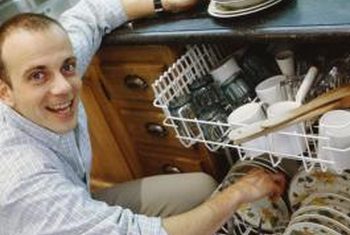 Buying a dishwasher is a joyful event for every woman. This modern unit will certainly become your faithful assistant in everyday life, it will save not only your precious time, but also the cost of water supply. Indeed, using a dishwasher you can significantly reduce water costs, since such devices are the most economical and convenient to use. Now you can wash all the dirty dishes at once quickly, and you do not have to do this yourself. The main thing is to ensure that dishwasher drain hose always remained in good condition.
Buying a dishwasher is a joyful event for every woman. This modern unit will certainly become your faithful assistant in everyday life, it will save not only your precious time, but also the cost of water supply. Indeed, using a dishwasher you can significantly reduce water costs, since such devices are the most economical and convenient to use. Now you can wash all the dirty dishes at once quickly, and you do not have to do this yourself. The main thing is to ensure that dishwasher drain hose always remained in good condition.
Unfortunately, household appliances are not eternal, and each device has its own specific resource, at the end of which it inevitably fails. However, it is possible to significantly extend the life of your kitchen, and not only helpers, if you carefully monitor their condition and properly care for them. The more complex the unit, the more care and additional funds it requires, but if you regularly check the performance of individual elements of the machine, you can do without expensive repairs.
Types of hoses for the dishwasher
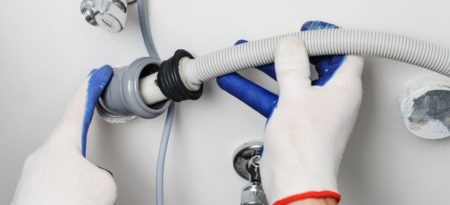
No matter how strange it may sound, the modern assortment of dishwashers is more reliably protected from leaks than the same washing machines. As a rule, all dishwashers are equipped with two hoses: drain and inlet, and usually the manufacturer gives a good guarantee on these products. In view of this, breakdowns of such accessories are quite rare. However, no one is safe from accidental damage that could result in a broken hose. Also, many consumers have faced situations where dishwasher inlet hose simply missing from the kit or was too short for a normal connection of the device.
In any case, you may need a drain hose for the dishwasher at the most inopportune moment, so you need to clearly understand how to make your choice and installation. If you began to notice that it was unsafe to use your dishwasher, then replacing the hose is simply necessary. This can be understood by leaks that will be inevitable in such a situation. Unlike replacing internal parts, changing the hose is not a difficult task, and absolutely anyone can cope with it.
![]() See also - How to choose a good washing powder?
See also - How to choose a good washing powder?
What is the best way to prepare for such a repair?
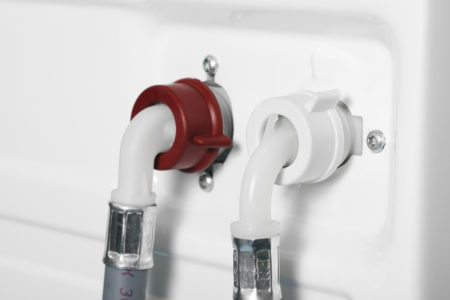 First you need to disconnect the unit from the network, sewerage and water supply. Now our task is to push the machine to an empty place, having previously spread cellophane or rags there, which will be necessary so that the remaining water in the device does not spread over the floor. No repair is complete without quality tools, in this case reliable pliers and screwdrivers will come in handy. It goes without saying that you should already have prepared the hoses - the drain and inlet hose for the dishwasher. To correctly select their length, measure the required distance, and remember that these elements should not be installed in a stretch.
First you need to disconnect the unit from the network, sewerage and water supply. Now our task is to push the machine to an empty place, having previously spread cellophane or rags there, which will be necessary so that the remaining water in the device does not spread over the floor. No repair is complete without quality tools, in this case reliable pliers and screwdrivers will come in handy. It goes without saying that you should already have prepared the hoses - the drain and inlet hose for the dishwasher. To correctly select their length, measure the required distance, and remember that these elements should not be installed in a stretch.
Today you can buy hoses with very different lengths from one and a half to five meters, but the most optimal products are considered to be two or two and a half meters. Another important point: any drain or dishwasher inlet hose must be necessarily equipped with a technical passport, which will indicate all its main parameters. These include the permissible water supply pressure, temperature, and so on. Today, these hoses are most often made of PVC with fittings and a plastic union nut. In addition, modern elements for draining or filling water can be equipped with a special Aqua stop valve, which prevents leaks.
![]() See also - Bosch dishwasher error code E24: meaning and solutions
See also - Bosch dishwasher error code E24: meaning and solutions
What is Aqua Stop?
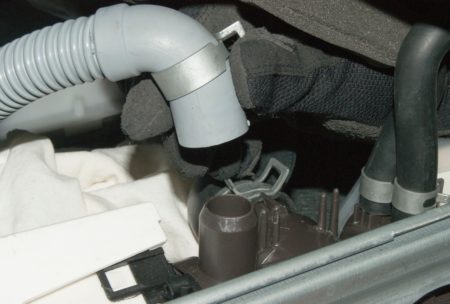 Today, when buying various household appliances, or accessories for it, you can hear from the seller the phrase Aqua stop, which is often applied to both washing machines and dishwashers. The aqua stop itself is an ordinary hose that is placed in a special casing with a device that blocks the water during an accident. This system is triggered at the time of a hose rupture or leakage, which helps to protect housing from a flood. Modern dishwashers from many manufacturers are already initially equipped with an aqua stop system, so you don't have to buy it separately.
Today, when buying various household appliances, or accessories for it, you can hear from the seller the phrase Aqua stop, which is often applied to both washing machines and dishwashers. The aqua stop itself is an ordinary hose that is placed in a special casing with a device that blocks the water during an accident. This system is triggered at the time of a hose rupture or leakage, which helps to protect housing from a flood. Modern dishwashers from many manufacturers are already initially equipped with an aqua stop system, so you don't have to buy it separately.
How do you know that a given device has worked? If your dishwasher stops working and does not want to pump water in any way, then it is worth checking the hose. To do this, turn off the water and unscrew the aquastop: if the valve behind the nut is tightly pressed, and you cannot see any gaps, then most likely the aquastop has worked. In such a situation, it is necessary to change the hose, and every consumer can cope with this task, since there is nothing difficult about this.
As a rule, to replace the aquastop drain or inlet hose, you just need to shut off the water and unscrew it, and screw a new one in place of the faulty one. If you have chosen an electromagnetic system, then in this case, you will also need to connect a wiring recognition sensor. Aquastop hoses are not useless, as the vast majority of users believe today. It will reliably protect your dishwasher from leaks and prevent flooding, which can be fraught not only with general cleaning in the kitchen, but also with expensive repairs from neighbors below.
![]() See also - The washing machine won't turn on - what should I do?
See also - The washing machine won't turn on - what should I do?
Sewer connection
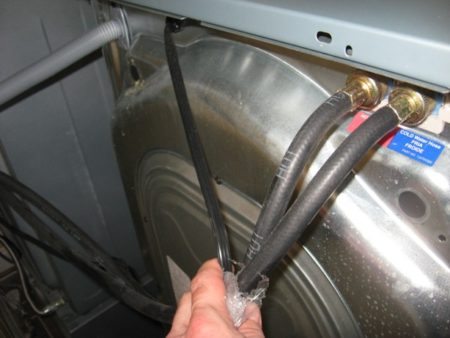 If the inlet hoses for the dishwasher can be connected without any special problems, then there may be problems with the drainage outlet. The most correct way to drain is to install a siphon through special valves that prevent water from flowing in the opposite direction. The drain hoses should be fixed to a wall or a special cabinet, about sixty centimeters high. It is necessary to bend it so that water flows without stagnation inside the device. Before connecting, it will not be superfluous to check the length of the hose, which should be enough so that it does not fit into an interference fit.
If the inlet hoses for the dishwasher can be connected without any special problems, then there may be problems with the drainage outlet. The most correct way to drain is to install a siphon through special valves that prevent water from flowing in the opposite direction. The drain hoses should be fixed to a wall or a special cabinet, about sixty centimeters high. It is necessary to bend it so that water flows without stagnation inside the device. Before connecting, it will not be superfluous to check the length of the hose, which should be enough so that it does not fit into an interference fit.
After you have fully connected the device, you need to run it idle for the first time to check the reliability of all connections.In the process, you will be able to determine the following:
- How quickly water is poured into the unit.
- Water heating quality.
- Check the drying process.
Remember that the first cycle must necessarily include all detergents and additional agents that are used to wash dishes. If you do not notice any abnormalities and the drain hose for the dishwasher is working properly, then the device can be used normally without fear.
![]() See also - Which company is better to choose a washing machine
See also - Which company is better to choose a washing machine
How to extend the life of your dishwasher
 Devices such as a dishwasher can cost a lot of money, besides, we usually buy large household appliances for more than one year, so proper operation and care of the parting is very important. If you do everything strictly according to the rules, then you can forget about repairing or replacing the machine for a long time.
Devices such as a dishwasher can cost a lot of money, besides, we usually buy large household appliances for more than one year, so proper operation and care of the parting is very important. If you do everything strictly according to the rules, then you can forget about repairing or replacing the machine for a long time.
- Make sure that your dishwasher is loaded correctly: the dishes should not go beyond the trays, as this will interfere with the normal operation of the device.
- The mesh filter should be washed regularly, preferably once a week. To do this, you will need to remove the lower basket and unscrew the fasteners.
- The same goes for the holes in the shower blades, be sure to check for debris or food debris.
- Every six months it is imperative to clean the seal on the door; for this, special detergents are used.
- Remember to clean your machine with a dishwasher detergent to keep your appliance looking good at all times.
Do not forget to choose the correct washing mode, in order to effectively wash certain types of dishes. In addition to the standard mode, such units have intensive wash programs, cycles for fragile dishes, quick wash, and so on. The more closely you follow the rules of operation, the longer you will be able to use your kitchen assistant. If you begin to notice that the device does not work as before, then you should contact a qualified technician who can quickly determine the type of breakdown. You should not try to make repairs on your own, because this can lead to irreversible consequences.
See also:
- 10 best ATLANT washing machines according to customer reviews
- 10 best built-in washing machines
- 10 best washing machines before 210 $ according to customer reviews
- 10 best washing machines before 350 $ according to customer reviews
- 13 best washing machines from 560–700 $ according to customer reviews

